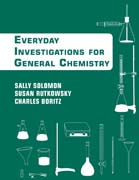
INDICE: I. Chemicals. II. Equipment/ Laboratory Techniques. III. Reporting Data/Results. IV. Safety. V. Experiments. Experiment 1. Density: Identifying Solids and Liquids. Experiment 2. Beer's Law, Copper Ammonium Complex. Experiment 3. Analysis of Food Dyes using Visible Spectroscopy & Paper Chromatography.Experiment 4. Determining the Formula of a Hydrate. Experiment 5. Quantitative Determination of P in Plant Food. Experiment 6. Preparation of Solutions. Experiment 7. Analysis of Spinach Extract. Experiment 8. Measuring pH with Universal Indicator. Experiment 9. Extraction of Curcumin from Turmeric. Experiment10. pH-Titration. Experiment 11. Preparation & Acid-Base Properties of Ammonium Chloride. Experiment 12. Boyle's Law. Experiment 13. Molar Mass of a Volatile Liquid by Vapor Density. Experiment 14. Percent of H2O2 by Gas Evolved. Experiment 15. Equilibrium and Le Châtelier's Principle. Experiment 16. Calorimetry: Measuring Heat of Neutralization. Experiment 17. Heat of Solution and Hot Packs. Experiment 18. Molar Mass by Freezing Point Depression. Experiment 19. Kinetics of the Iodination of Acetone. Experiment 20. Kinetics of the Oxidation of Food Dye with Sodium Hypochlorite. Experiment 21. Redox Titration: Iodineused to Determine Ascorbic Acid. Experiment 22. Electrochemistry. Experiment 23. Synthesis of Copper Nanoparticles. Experiment 24. Synthesis of Copper Pigments: Making Paints. Experiment 25. Synthesis of Ethyl Salicylate from AspirinTablets. Experiment 26. Qualitative Analysis of Household Compounds and Mixtures. Experiment 27. Measuring Potassium-40 in Salt Products. Appendix. Table of Available Chemicals.
- ISBN: 978-0-470-08510-3
- Editorial: John Wiley & Sons
- Encuadernacion: Rústica
- Páginas: 312
- Fecha Publicación: 15/05/2008
- Nº Volúmenes: 1
- Idioma: Inglés
